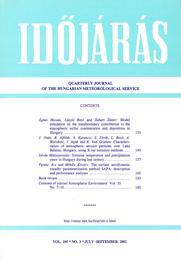Időjárás - Quarterly Journal of the Hungarian Meteorological Service (OMSZ)
Vol. 105, No. 3 * Pages 135–188 * July - September 2001
 |
|
 download [pdf: 23734 KB]
download [pdf: 23734 KB]
Model simulation on the transboundary contribution to the atmospheric sulfur concentration and deposition in Hungary
Havasi Ágnes, Bozó László, Zlatev, Z.
idojaras.2001.3.1 (p. 135–)
Havasi Ágnes, Bozó László, Zlatev, Z.
idojaras.2001.3.1 (p. 135–)
Characterization of atmospheric aerosol particles over Lake Balaton, Hungary, using X-ray emission methods
Osán, J., Alföldy, B., Kurunczi, S., Török, S., Bozó László, Worobiec, A., Injuk, J., Van Grieken, R.
idojaras.2001.3.2 (p. 145–)
Osán, J., Alföldy, B., Kurunczi, S., Török, S., Bozó László, Worobiec, A., Injuk, J., Van Grieken, R.
idojaras.2001.3.2 (p. 145–)
Extreme temperature and precipitation years in Hungary during last century
Matyasovszky István
idojaras.2001.3.3 (p. 157–)
Matyasovszky István
idojaras.2001.3.3 (p. 157–)
The surface aerodynamic transfer parameterization method SAPA: description and performance analyses
Ács Ferenc, Kovács Mihály
idojaras.2001.3.4 (p. 165–)
Ács Ferenc, Kovács Mihály
idojaras.2001.3.4 (p. 165–)
IDŐJÁRÁS - Quarterly Journal

Az IDŐJÁRÁS a HungaroMet Nonprofit Zrt. negyedévenként megjelenő angol nyelvű folyóirata
Megrendelhető a journal.idojaras@met.hu címen.
A szerzőknek szánt útmutató itt olvasható.
Megrendelhető a journal.idojaras@met.hu címen.
A szerzőknek szánt útmutató itt olvasható.









